Terry Odell's Blog, page 281
May 28, 2011
And The Winner Is ...
The winner of Sarah Grimmm's book, NOT WITHOUT RISK, is ... KAREN!
Karen, email Sarah at Sarah (at) Sarahgrimm (dot) com to arrange to get your prize. Thanks to all who entered.
And don't forget, I'm running my monthly contest, and there are only a few days left to enter. Click the contest tab above for details.
Karen, email Sarah at Sarah (at) Sarahgrimm (dot) com to arrange to get your prize. Thanks to all who entered.
And don't forget, I'm running my monthly contest, and there are only a few days left to enter. Click the contest tab above for details.
Published on May 28, 2011 06:00
May 27, 2011
Friday Field Trip: Mollie Kathleen 1
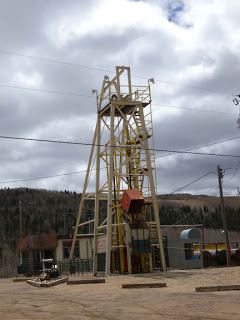 Hubster and I went to Cripple Creek for an overnight on Tuesday. The weather was NOT conducive to picture taking. I'm talking snow, cold, and gloomy skies. But on Wednesday, things were better, and on our drive home, we stopped to tour the Mollie Kathleen mine. The tour takes you down 1000 feet. This week, we'll look at what it was like down there, and next week, I'll share some of the pictures from up top.
Hubster and I went to Cripple Creek for an overnight on Tuesday. The weather was NOT conducive to picture taking. I'm talking snow, cold, and gloomy skies. But on Wednesday, things were better, and on our drive home, we stopped to tour the Mollie Kathleen mine. The tour takes you down 1000 feet. This week, we'll look at what it was like down there, and next week, I'll share some of the pictures from up top.There were 5 of us plus a guide on the tour. We barely squeezed into a cage that was supposed to hold 8 miners for the descent to 1000 feet. Those guys must have been small. Small wonder they posted this sign at the top:
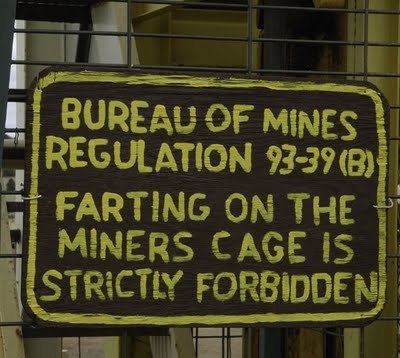
Down below, we were given demonstrations of tools and mining methods, and how they progressed with time. The tunnels were dimly lit, but our guide would show us the reality by turning of the "tourist" lighting, leaving us to see what the miners had to deal with. Between the dark and the noise of the jackhammers and drills, working conditions would hardly pass today's standards. (They used to use burros to do the work, and they lived their entire lives in the mine until regulations said they had to be brought topside once a day. The cost was prohibitive, so they simply brought them up and released them, leaving men to do what the burros had done. They had a car loaded with its "normal" load of a ton of ore. A burro could pull 2. Neither of the men brave enough to try could move it more than a few inches.
So -- these are some views from inside the mine:
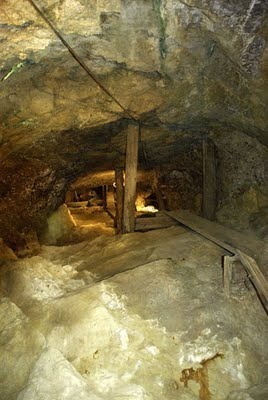
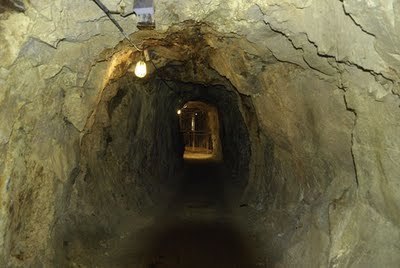
This was how the foreman got around:
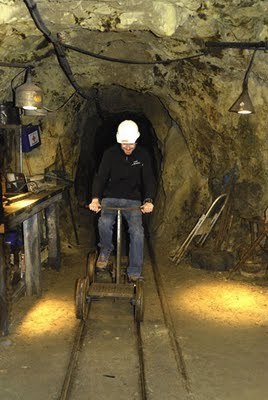
Cripple Creek ore is purple: this is a vein discovered not that long ago, although it's not cost effective to mine it.

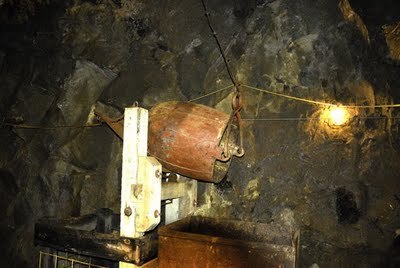
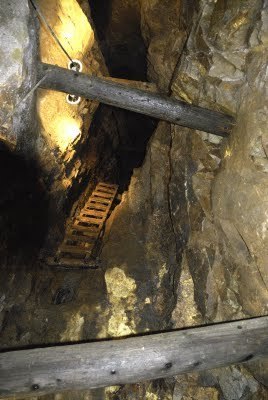
When we got back up, we wandered around and took pictures of some of the equipment and vistas. Those will be my field trip next Friday. And don't forget to leave a comment on Sarah Grimm's Tuesday post for a chance to win her book! Have a great weekend.
Published on May 27, 2011 04:00
May 26, 2011
Grand Openings
There are only a few days left to sign up for my Dialogue Basics workshop at the Savvy Authors site. Link in the sidebar. And if you read yesterday's post on basic html, there was an error, which I corrected, so if you read it early in the day, you should go back and note the changes. And don't forget, Tuesday's guest, Sarah Grimm, is giving away a book to a commenter. Scroll down and leave a comment under her post.
This past Sunday, I drove "all the way down the mountain" to Colorado Springs to hear literary agent Rachelle Gardner speak on openings. I'm going to hit some of the high points in this post.
Since I'm starting a new book, I'm facing that dilemma, and it doesn't get any easier. And, since Hubster read the first scene of my efforts and said, "I don't like the first line," I figured it couldn't hurt to have a 'refresher' course in what an opening should do.
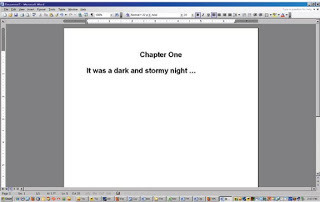 Rachelle spoke as an agent, but we also discussed things from a reader's point of view. If you're submitting, that opening has to attract an agent's attention. If you're published, you're convincing the reader to buy your book, and not one of the other kazillion on the shelf.
Rachelle spoke as an agent, but we also discussed things from a reader's point of view. If you're submitting, that opening has to attract an agent's attention. If you're published, you're convincing the reader to buy your book, and not one of the other kazillion on the shelf.
She gave us some excellent reasons why openings are so hard to write. The first, that as the author, you've probably got an emotional attachment to your opening scene because you've envisioned it for days, weeks, months or years. But it might not be the best way into your story.
Or, you don't really now where they story begins.
Or, you don't have a true feel for the theme or premise until you've finished the book.
(For the record, the second one fits me best.)
An opening should start with some kind of conflict. There needs to be something that will intrigue the reader into wanting to know what comes next.
She warned against:
Using gimmicks, or trying to be clever in your first sentences.
Opening with the weather (we've heard that one)
Opening with a dream sequence, which will make the reader have to backtrack.
Opening with a line of dialogue. (We've often heard that this is a good way into the book, but if your reader doesn't know the characters, these are just words out of the blue).
Opening with some mundane action just so you can show what your character is thinking about. (Amounts to a back story dump)
And, sometimes a "bad" opening is simply "bad" because it's been done too many times. Her example from romance: Young heroine returns to her small town home for a funeral. She's likely inherited something she doesn't want, and will fall in love with her high school sweetheart. Yes, there's lots of room for conflict, but because Rachelle sees so many of these, if you're writing one, it's going to have to have a unique twist, and be superbly written.
Dumping back story is something I've talked about here, and in some of my guest blog posts—avoid that R.U.E. I compare back story to an IV drip rather than tube feeding. Or, the cocktail party analogy. How much do you tell someone you're meeting for the first time. So, I was pleased to hear Rachelle say writers should ask themselves if the reader needs to know this "right this minute."
And yes, it's hard. In just a few paragraphs, you have to introduce your protagonist, give him something to deal with, and make the reader care. There has to be tension and conflict, and often writers try too hard to set up the character to engage the reader. Or they go too far the other way and set up an exciting, action-packed sequence, but we don't know whose side we're supposed to be on, or why.
That first page needs to show some kind of action. It needs to be a page-turner. It has to be unique. There has to be tension and conflict. And there has to be something at stake for the character. He has to want something.
In short, the book should open at the point where things get interesting.
Another excellent reminder she gave was that scenes have to END at a rising point of tension. I know when I wrote my first book, I didn't even put in chapter breaks. I went back and did that when I finished, and they were almost all at the "resolution" point of the chapter. Yawn. Then, I found that if I simply backed up a few paragraphs, I had a much better ending point. And as I continue to write, I'm much more aware of this, and I've got lots of scenes in WIPs that have my note, "Needs a hook."
Which brings me to another important point. You don't have to have that perfect beginning right away. Don't sweat it. Write what you think works, then finish the book and go back and fix the beginning. By then, you'll have a much better idea of conflicts and themes.
At the end of the workshop, Rachelle read a few first pages submitted by attendees, and we discussed what worked, and what didn't, and why.
The protagonist has to be clearly the character with something at stake. There were a couple of examples where the author explained what was happening, or going to happen later in the book, but it didn't come through in the opening. If your reader is confused now, there's not likely to be any later.
As always, "rules" are "guidelines. She read one sample that opened with the weather and a funeral, and it clicked for her.
And now – here's my opening—the one Hubster didn't like. Any thoughts? Does it serve any of the functions of those opening lines?
"You'll do well to get rid of that chip on your shoulder before you report to Chief Laughlin."
Without removing his gaze from his lieutenant, Scott Whelan swiped the fingers of his left hand across both shoulders. "Yes, sir. Chip removed, sir. Is that all?"
This past Sunday, I drove "all the way down the mountain" to Colorado Springs to hear literary agent Rachelle Gardner speak on openings. I'm going to hit some of the high points in this post.
Since I'm starting a new book, I'm facing that dilemma, and it doesn't get any easier. And, since Hubster read the first scene of my efforts and said, "I don't like the first line," I figured it couldn't hurt to have a 'refresher' course in what an opening should do.
 Rachelle spoke as an agent, but we also discussed things from a reader's point of view. If you're submitting, that opening has to attract an agent's attention. If you're published, you're convincing the reader to buy your book, and not one of the other kazillion on the shelf.
Rachelle spoke as an agent, but we also discussed things from a reader's point of view. If you're submitting, that opening has to attract an agent's attention. If you're published, you're convincing the reader to buy your book, and not one of the other kazillion on the shelf.She gave us some excellent reasons why openings are so hard to write. The first, that as the author, you've probably got an emotional attachment to your opening scene because you've envisioned it for days, weeks, months or years. But it might not be the best way into your story.
Or, you don't really now where they story begins.
Or, you don't have a true feel for the theme or premise until you've finished the book.
(For the record, the second one fits me best.)
An opening should start with some kind of conflict. There needs to be something that will intrigue the reader into wanting to know what comes next.
She warned against:
Using gimmicks, or trying to be clever in your first sentences.
Opening with the weather (we've heard that one)
Opening with a dream sequence, which will make the reader have to backtrack.
Opening with a line of dialogue. (We've often heard that this is a good way into the book, but if your reader doesn't know the characters, these are just words out of the blue).
Opening with some mundane action just so you can show what your character is thinking about. (Amounts to a back story dump)
And, sometimes a "bad" opening is simply "bad" because it's been done too many times. Her example from romance: Young heroine returns to her small town home for a funeral. She's likely inherited something she doesn't want, and will fall in love with her high school sweetheart. Yes, there's lots of room for conflict, but because Rachelle sees so many of these, if you're writing one, it's going to have to have a unique twist, and be superbly written.
Dumping back story is something I've talked about here, and in some of my guest blog posts—avoid that R.U.E. I compare back story to an IV drip rather than tube feeding. Or, the cocktail party analogy. How much do you tell someone you're meeting for the first time. So, I was pleased to hear Rachelle say writers should ask themselves if the reader needs to know this "right this minute."
And yes, it's hard. In just a few paragraphs, you have to introduce your protagonist, give him something to deal with, and make the reader care. There has to be tension and conflict, and often writers try too hard to set up the character to engage the reader. Or they go too far the other way and set up an exciting, action-packed sequence, but we don't know whose side we're supposed to be on, or why.
That first page needs to show some kind of action. It needs to be a page-turner. It has to be unique. There has to be tension and conflict. And there has to be something at stake for the character. He has to want something.
In short, the book should open at the point where things get interesting.
Another excellent reminder she gave was that scenes have to END at a rising point of tension. I know when I wrote my first book, I didn't even put in chapter breaks. I went back and did that when I finished, and they were almost all at the "resolution" point of the chapter. Yawn. Then, I found that if I simply backed up a few paragraphs, I had a much better ending point. And as I continue to write, I'm much more aware of this, and I've got lots of scenes in WIPs that have my note, "Needs a hook."
Which brings me to another important point. You don't have to have that perfect beginning right away. Don't sweat it. Write what you think works, then finish the book and go back and fix the beginning. By then, you'll have a much better idea of conflicts and themes.
At the end of the workshop, Rachelle read a few first pages submitted by attendees, and we discussed what worked, and what didn't, and why.
The protagonist has to be clearly the character with something at stake. There were a couple of examples where the author explained what was happening, or going to happen later in the book, but it didn't come through in the opening. If your reader is confused now, there's not likely to be any later.
As always, "rules" are "guidelines. She read one sample that opened with the weather and a funeral, and it clicked for her.
And now – here's my opening—the one Hubster didn't like. Any thoughts? Does it serve any of the functions of those opening lines?
"You'll do well to get rid of that chip on your shoulder before you report to Chief Laughlin."
Without removing his gaze from his lieutenant, Scott Whelan swiped the fingers of his left hand across both shoulders. "Yes, sir. Chip removed, sir. Is that all?"
Published on May 26, 2011 04:00
May 25, 2011
Some VERY basic HTML
Thanks to Sarah Grimm for her post. Author Meg Chittenden once said writers are lucky because we hear voices in our heads but don't get locked up in rubber rooms. Hubster and I are at Cripple Creek most of today, so I won't be around to respond to comments as often as I'd like to. But don't let that stop you from leaving them, or sharing this post if it's at all helpful.
Back when I started my first personal website—back in the day when it was a cool thing to play with because your internet provider offered a certain amount of "free" space along with your account—I tried to figure out what the heck I was doing. I even bought a book about HTML, not that I understood it. (HTML 3 if that says anything about how long ago it was.)
 Image copyright John C. Dvorak (And no, it's not real. It's a setup)
Image copyright John C. Dvorak (And no, it's not real. It's a setup)
Now, most simple interfaces include automatic formatting codes, but there are a few commands I still use when you can't just highlight a word and click something that will insert the code for you. The main places I use them is when I leave blog comments, or am creating hyperlinks on my own blog. They also help me understand and find code when I'm trying to figure out why my blog or web page doesn't look right.
First, the bare bones. You signal whatever cyberspace magicians by inserting codes between < and > marks. Then you tell it to stop with a "/" symbol before the letter between the < and > marks
Okay, here's where it's going to get a little confusing, because Blogger insists that my examples are actually real HTML code. So, from here on out, I'm going to use "[" to represent "<" and "]" to represent ">".
To make something show up in bold, you use the character b (easy enough to remember, right?) So to bold something, you put [b] before the first word you want in bold and you put [/b] after the last word.
Same goes for italics, but use the letter i instead of b.
And if you want to get fancy, you can do bold italics; just remember to close the tags in the opposite order. So if you start with [i] [b], then end with [/b] [/i]
Creating links is usually programmed into the interface you're using, but it's one command I finally committed to memory, because, as I mentioned above, when things don't go right, it's nice to be able to see why, and to fix it.
Let's say I want to link to my website. The trigger for that kind of command is [a href="http://terryodell.blogspot.com/2011/0...
The command goes IN FRONT of the text you want to be the link. In this case, let's say the text is "see my website." If the word I'd want to turn into the link is "website," then I put the [a href="http://terryodell.blogspot.com/2011/0... before website.
Then, after the quotes, you insert the URL of the website you want to link to. For my website, it would be http://www.terryodell.com
Then, close the quotes and put another ] symbol.
Next, AFTER the linked word, tell the internet magicians you're done by adding /a]
Don't ask my why you don't put the a inside [] for this one—I don't pretend to understand any of this. I just learned how to DO it.
So, the finished product would be:
See my [a href=http://www.terryodell.com"] website /a]
The next (and probably last) command I learned had to do with telling the magicians that I didn't want people to be navigating away from my page. I wanted the link to open in another window. That way, my readers can have both the initial page and my website open at the same time. And this option isn't given for a lot of places that will create the basic link for you. By knowing what the link code is, I know what to look for and where to add the "open in a new window" bit.
Now, I'm sure there are lots of you who are going to say, "Just right click on the link, and you'll get the choice of where you want it to open." Trouble is, I never remember to do that, so I prefer to add a little more code so that the link will open in a new window automatically in case there are others like me out there.
The code for that is target="_blank"
You put that code after the closing quotes of the URL, before the ]
So, the final product would be [a href=http://www.terryodell.com" target="_blank"] website /a]
I leave a space between the quotes and the target and have never tried it without one. It ain't broke, so I don't want to fix it.
Hope this wasn't too confusing. I had the pages explaining this flagged in my 'how to' book and had to refer to it for a long, long, time before finally committing it to memory.
Tomorrow, I'm going to be recapping the highlights of agent Rachelle Gardner's presentation on openings. Please come back.
Back when I started my first personal website—back in the day when it was a cool thing to play with because your internet provider offered a certain amount of "free" space along with your account—I tried to figure out what the heck I was doing. I even bought a book about HTML, not that I understood it. (HTML 3 if that says anything about how long ago it was.)
 Image copyright John C. Dvorak (And no, it's not real. It's a setup)
Image copyright John C. Dvorak (And no, it's not real. It's a setup)Now, most simple interfaces include automatic formatting codes, but there are a few commands I still use when you can't just highlight a word and click something that will insert the code for you. The main places I use them is when I leave blog comments, or am creating hyperlinks on my own blog. They also help me understand and find code when I'm trying to figure out why my blog or web page doesn't look right.
First, the bare bones. You signal whatever cyberspace magicians by inserting codes between < and > marks. Then you tell it to stop with a "/" symbol before the letter between the < and > marks
Okay, here's where it's going to get a little confusing, because Blogger insists that my examples are actually real HTML code. So, from here on out, I'm going to use "[" to represent "<" and "]" to represent ">".
To make something show up in bold, you use the character b (easy enough to remember, right?) So to bold something, you put [b] before the first word you want in bold and you put [/b] after the last word.
Same goes for italics, but use the letter i instead of b.
And if you want to get fancy, you can do bold italics; just remember to close the tags in the opposite order. So if you start with [i] [b], then end with [/b] [/i]
Creating links is usually programmed into the interface you're using, but it's one command I finally committed to memory, because, as I mentioned above, when things don't go right, it's nice to be able to see why, and to fix it.
Let's say I want to link to my website. The trigger for that kind of command is [a href="http://terryodell.blogspot.com/2011/0...
The command goes IN FRONT of the text you want to be the link. In this case, let's say the text is "see my website." If the word I'd want to turn into the link is "website," then I put the [a href="http://terryodell.blogspot.com/2011/0... before website.
Then, after the quotes, you insert the URL of the website you want to link to. For my website, it would be http://www.terryodell.com
Then, close the quotes and put another ] symbol.
Next, AFTER the linked word, tell the internet magicians you're done by adding /a]
Don't ask my why you don't put the a inside [] for this one—I don't pretend to understand any of this. I just learned how to DO it.
So, the finished product would be:
See my [a href=http://www.terryodell.com"] website /a]
The next (and probably last) command I learned had to do with telling the magicians that I didn't want people to be navigating away from my page. I wanted the link to open in another window. That way, my readers can have both the initial page and my website open at the same time. And this option isn't given for a lot of places that will create the basic link for you. By knowing what the link code is, I know what to look for and where to add the "open in a new window" bit.
Now, I'm sure there are lots of you who are going to say, "Just right click on the link, and you'll get the choice of where you want it to open." Trouble is, I never remember to do that, so I prefer to add a little more code so that the link will open in a new window automatically in case there are others like me out there.
The code for that is target="_blank"
You put that code after the closing quotes of the URL, before the ]
So, the final product would be [a href=http://www.terryodell.com" target="_blank"] website /a]
I leave a space between the quotes and the target and have never tried it without one. It ain't broke, so I don't want to fix it.
Hope this wasn't too confusing. I had the pages explaining this flagged in my 'how to' book and had to refer to it for a long, long, time before finally committing it to memory.
Tomorrow, I'm going to be recapping the highlights of agent Rachelle Gardner's presentation on openings. Please come back.
Published on May 25, 2011 04:00
May 24, 2011
The Voices in my Head
Today, I'm turning Terry's Place over to author Sarah Grimm. Hubster and I are off to Cripple Creek for a couple of days, but I know you're in good hands here today.
Sarah Grimm, writes romantic suspense and contemporary romance for The Wild Rose Press. As a young girl, Sarah always had a story to tell. At times they were funny, other times scary, but they were always happily-ever-after. Sarah is here today to tell us a little bit about the voices in her head.
Leave a comment today and Sarah will award one of you an electronic copy of her LASR Best Book of 2010 nominated romantic suspense, NOT WITHOUT RISK.
 As an author I get asked all the time how I come up with my stories. This is a great question and applies to all creative people. How do we do what we do? For me, it has to do with the voices in my head. Yes, you read it correctly, the voices in my head. No, these voices don't tell me to do things like hurt people. If they did, I'd have myself committed.
As an author I get asked all the time how I come up with my stories. This is a great question and applies to all creative people. How do we do what we do? For me, it has to do with the voices in my head. Yes, you read it correctly, the voices in my head. No, these voices don't tell me to do things like hurt people. If they did, I'd have myself committed.
So what do I mean by the voices in my head? Simply this; at all times, in all situations, there is a character in my head talking to me, or more accurately, talking to another character. Sounds insane, I know, but it's true.
The characters in my stories are real to me long before I begin to put them down on a page simply because they've lived with me for quite some time before I write about them. They sit in my head, feeding me insight to their hearts and souls at the oddest times. They converse with the other characters about what makes them similar or different from each other. Believe it or not, they even complain. Maybe I'm not listening or haven't gotten to their story quickly enough to satisfy them.
I'm struggling with that right now. I'm about half done with a story called MIDNIGHT HEAT and just started a new job. Eek!
Anyway, as I spend each day entering invoices into an accounting program I've never worked with before, and filling out the massive amount of paperwork the government requires farmers to file each year, my hero has made it known that he expects his HEA to happen soon. Very soon, if his sulking is any indication, or if I wish to hold onto what little sanity I have left.
I'd better get back to it…
Sarah lives in West Michigan with her husband, two sons and three miniature schnauzers. Find Sarah online at her website: http://www.sarahgrimm.com, her blog: http://www.authorsarahgrimm.blogspot.com, or on Twitter.
http://www.twitter.com/SGrimmAuthor

Sarah Grimm, writes romantic suspense and contemporary romance for The Wild Rose Press. As a young girl, Sarah always had a story to tell. At times they were funny, other times scary, but they were always happily-ever-after. Sarah is here today to tell us a little bit about the voices in her head.
Leave a comment today and Sarah will award one of you an electronic copy of her LASR Best Book of 2010 nominated romantic suspense, NOT WITHOUT RISK.
 As an author I get asked all the time how I come up with my stories. This is a great question and applies to all creative people. How do we do what we do? For me, it has to do with the voices in my head. Yes, you read it correctly, the voices in my head. No, these voices don't tell me to do things like hurt people. If they did, I'd have myself committed.
As an author I get asked all the time how I come up with my stories. This is a great question and applies to all creative people. How do we do what we do? For me, it has to do with the voices in my head. Yes, you read it correctly, the voices in my head. No, these voices don't tell me to do things like hurt people. If they did, I'd have myself committed.So what do I mean by the voices in my head? Simply this; at all times, in all situations, there is a character in my head talking to me, or more accurately, talking to another character. Sounds insane, I know, but it's true.
The characters in my stories are real to me long before I begin to put them down on a page simply because they've lived with me for quite some time before I write about them. They sit in my head, feeding me insight to their hearts and souls at the oddest times. They converse with the other characters about what makes them similar or different from each other. Believe it or not, they even complain. Maybe I'm not listening or haven't gotten to their story quickly enough to satisfy them.
I'm struggling with that right now. I'm about half done with a story called MIDNIGHT HEAT and just started a new job. Eek!
Anyway, as I spend each day entering invoices into an accounting program I've never worked with before, and filling out the massive amount of paperwork the government requires farmers to file each year, my hero has made it known that he expects his HEA to happen soon. Very soon, if his sulking is any indication, or if I wish to hold onto what little sanity I have left.
I'd better get back to it…
Sarah lives in West Michigan with her husband, two sons and three miniature schnauzers. Find Sarah online at her website: http://www.sarahgrimm.com, her blog: http://www.authorsarahgrimm.blogspot.com, or on Twitter.
http://www.twitter.com/SGrimmAuthor
Published on May 24, 2011 05:00
May 23, 2011
Compromises
What I'm reading: Sixkill, by Robert B. Parker
 During our renovations and remodels, we found ourselves compromising on a lot of issues. Sometimes it was a matter of money—deciding what things we were willing to cut from our dream plan, and where we were willing to shell out the extra cash. We decided to go with underfloor heating in the bathrooms. However, a custom job, with the heat mat made to order for the bathroom was prohibitively costly compared with the off the shelf versions. The compromise meant we were restricted to the sizes the mats came in; we couldn't get the heat mat under the tile of the entire bathroom, leaving a few areas where the tiles remain cold. But having that extra course of tiles heated wasn't worth the price differential. It was easier to learn to take a bigger step into the hall bath if you were barefoot, avoiding the first row of tiles.
During our renovations and remodels, we found ourselves compromising on a lot of issues. Sometimes it was a matter of money—deciding what things we were willing to cut from our dream plan, and where we were willing to shell out the extra cash. We decided to go with underfloor heating in the bathrooms. However, a custom job, with the heat mat made to order for the bathroom was prohibitively costly compared with the off the shelf versions. The compromise meant we were restricted to the sizes the mats came in; we couldn't get the heat mat under the tile of the entire bathroom, leaving a few areas where the tiles remain cold. But having that extra course of tiles heated wasn't worth the price differential. It was easier to learn to take a bigger step into the hall bath if you were barefoot, avoiding the first row of tiles.
Another compromise – we had a lot more room in our former house. Finding places for things that went into our wall units and china cabinet meant more furniture. We ended up with a large curio cabinet in the living area. However, it doesn't have any interior lighting, so as far as displaying treasures goes, it's not really the perfect system. We ordered two more bookcases for the downstairs, but when they arrived, we realized that one was a shade too tall for where we wanted to put it. (Never thought about the bulkhead ceiling on that side of the room, or how tall the bookcases would be.) So, we found another spot for the second unit, which ate up several feet of wall space, meaning when we get furniture for the room, we're going to be limited in what will fit where.
When writing, you'll also learn to make compromises—unless, of course, you're writing strictly for yourself. Everyone says 'write the book of your heart.' But if you want people to read your books, you're going to have to consider what the readers want. The book of your heart just might not be marketable.
Somewhere along the line, you have to decide which battles are worth fighting and which aren't. Some, you'll never win. If a publisher wants humor, and you're not a funny person, maybe that's the time to realize that your efforts might be better spent elsewhere. Or maybe they want deep, dark suspense, full of serial killers and psychopaths, and you prefer lighthearted mystery. Are you capable of writing what they want? Will you feel like you're struggling to get each word on the page? Assuming you've done your homework and submitted your work to a publisher who publishes what you write, and it's accepted, what's next?. You're going to have to deal with an editor who works for the publisher, and knows what they're looking (or not looking) for.
For example, my editor for WHEN DANGER CALLS told me the publisher would nix any use of the word 'penis.' She said their readers didn't like to read it. Was there a point to arguing with this one? No. Easy enough to change. On a grander scale, some genres have their own reader expectations and publishers have their own guidelines.
Once you're aware of what your publisher and editor expect, you'll find that you're compromising with yourself during the writing process. Just like you learn to avoid that first course of tiles in the bathroom, you won't use those 'forbidden' words. If you're writing a contemporary series romance, you'll learn to get your hero and heroine on the page and involved immediately, because that's what readers of that genre want, and the publisher expects you to meet their expectations.
Tomorrow, my guest is author Sarah Grimm, who's going to be telling us about the voices in her head.
 During our renovations and remodels, we found ourselves compromising on a lot of issues. Sometimes it was a matter of money—deciding what things we were willing to cut from our dream plan, and where we were willing to shell out the extra cash. We decided to go with underfloor heating in the bathrooms. However, a custom job, with the heat mat made to order for the bathroom was prohibitively costly compared with the off the shelf versions. The compromise meant we were restricted to the sizes the mats came in; we couldn't get the heat mat under the tile of the entire bathroom, leaving a few areas where the tiles remain cold. But having that extra course of tiles heated wasn't worth the price differential. It was easier to learn to take a bigger step into the hall bath if you were barefoot, avoiding the first row of tiles.
During our renovations and remodels, we found ourselves compromising on a lot of issues. Sometimes it was a matter of money—deciding what things we were willing to cut from our dream plan, and where we were willing to shell out the extra cash. We decided to go with underfloor heating in the bathrooms. However, a custom job, with the heat mat made to order for the bathroom was prohibitively costly compared with the off the shelf versions. The compromise meant we were restricted to the sizes the mats came in; we couldn't get the heat mat under the tile of the entire bathroom, leaving a few areas where the tiles remain cold. But having that extra course of tiles heated wasn't worth the price differential. It was easier to learn to take a bigger step into the hall bath if you were barefoot, avoiding the first row of tiles.Another compromise – we had a lot more room in our former house. Finding places for things that went into our wall units and china cabinet meant more furniture. We ended up with a large curio cabinet in the living area. However, it doesn't have any interior lighting, so as far as displaying treasures goes, it's not really the perfect system. We ordered two more bookcases for the downstairs, but when they arrived, we realized that one was a shade too tall for where we wanted to put it. (Never thought about the bulkhead ceiling on that side of the room, or how tall the bookcases would be.) So, we found another spot for the second unit, which ate up several feet of wall space, meaning when we get furniture for the room, we're going to be limited in what will fit where.
When writing, you'll also learn to make compromises—unless, of course, you're writing strictly for yourself. Everyone says 'write the book of your heart.' But if you want people to read your books, you're going to have to consider what the readers want. The book of your heart just might not be marketable.
Somewhere along the line, you have to decide which battles are worth fighting and which aren't. Some, you'll never win. If a publisher wants humor, and you're not a funny person, maybe that's the time to realize that your efforts might be better spent elsewhere. Or maybe they want deep, dark suspense, full of serial killers and psychopaths, and you prefer lighthearted mystery. Are you capable of writing what they want? Will you feel like you're struggling to get each word on the page? Assuming you've done your homework and submitted your work to a publisher who publishes what you write, and it's accepted, what's next?. You're going to have to deal with an editor who works for the publisher, and knows what they're looking (or not looking) for.
For example, my editor for WHEN DANGER CALLS told me the publisher would nix any use of the word 'penis.' She said their readers didn't like to read it. Was there a point to arguing with this one? No. Easy enough to change. On a grander scale, some genres have their own reader expectations and publishers have their own guidelines.
Once you're aware of what your publisher and editor expect, you'll find that you're compromising with yourself during the writing process. Just like you learn to avoid that first course of tiles in the bathroom, you won't use those 'forbidden' words. If you're writing a contemporary series romance, you'll learn to get your hero and heroine on the page and involved immediately, because that's what readers of that genre want, and the publisher expects you to meet their expectations.
Tomorrow, my guest is author Sarah Grimm, who's going to be telling us about the voices in her head.
Published on May 23, 2011 04:00
May 20, 2011
Friday Field Trip: Columbia Gorge and the Oregon Coast
Guess who's back? Right. Jason Odell. He's been traveling, which means ... you guessed it ... pictures. And, as always, click to enlarge. Welcome, Jason.
For the past five years, I've co-hosted a photography podcast on iTunes, called The Image Doctors. Each year, we lead a "photo safari" to a fun location. This year, we chose to photograph in Oregon; specifically the Columbia River Gorge and the central coast near Newport. Not only does Oregon offer breathtaking scenery, but it's also the home of good microbrew and amazing cheese and ice cream (we do plan our trips around local cuisine, when possible). These photos represent a sample of the kinds of photographs you can make there, provided you have a tripod for your camera.
The Columbia River Gorge parallels Interstate 84, and it is absolutely full of spectacular waterfalls. If you go, an overcast day is best. Avoid the weekends because the crowds get thick and it can be tough to park. Midweek, you can just about have the whole place to yourself. After we photographed in the Gorge, we relocated from Portland to the town of Newport. There are lots of great little seaside towns, but here was a spot that gave us access to a variety of locations within a two-hour drive. Newport is also home to the Rogue brewing company; a mandatory stop if you like microbrews. We photographed the lighthouses at Yaquina Head, Cape Meares, and Heceta Head. At sunset, we shot in spots like Seal Rock and along the beach in the town of Oceanside, near Tillamook. At Tillamook, we stopped in to the Tillamook Cheese factory for cheese samples and homemade ice cream.
Multnomah Falls (Columbia Gorge, near Portland)

Newport Harbor (Yaquina Bay)

Yaquina Head Lighthouse

Cape Meares

Three Arch Rocks

Harbor Seals
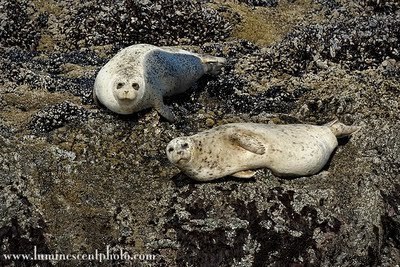
Heceta Head Lighthouse

Seal Rock

For more information about Jason's photography, visit www.luminescentphoto.com
The Image Doctors photography podcast can be found on iTunes or at www.theimagedoctors.com
For the past five years, I've co-hosted a photography podcast on iTunes, called The Image Doctors. Each year, we lead a "photo safari" to a fun location. This year, we chose to photograph in Oregon; specifically the Columbia River Gorge and the central coast near Newport. Not only does Oregon offer breathtaking scenery, but it's also the home of good microbrew and amazing cheese and ice cream (we do plan our trips around local cuisine, when possible). These photos represent a sample of the kinds of photographs you can make there, provided you have a tripod for your camera.
The Columbia River Gorge parallels Interstate 84, and it is absolutely full of spectacular waterfalls. If you go, an overcast day is best. Avoid the weekends because the crowds get thick and it can be tough to park. Midweek, you can just about have the whole place to yourself. After we photographed in the Gorge, we relocated from Portland to the town of Newport. There are lots of great little seaside towns, but here was a spot that gave us access to a variety of locations within a two-hour drive. Newport is also home to the Rogue brewing company; a mandatory stop if you like microbrews. We photographed the lighthouses at Yaquina Head, Cape Meares, and Heceta Head. At sunset, we shot in spots like Seal Rock and along the beach in the town of Oceanside, near Tillamook. At Tillamook, we stopped in to the Tillamook Cheese factory for cheese samples and homemade ice cream.
Multnomah Falls (Columbia Gorge, near Portland)

Newport Harbor (Yaquina Bay)

Yaquina Head Lighthouse

Cape Meares

Three Arch Rocks

Harbor Seals

Heceta Head Lighthouse

Seal Rock

For more information about Jason's photography, visit www.luminescentphoto.com
The Image Doctors photography podcast can be found on iTunes or at www.theimagedoctors.com
Published on May 20, 2011 04:00
May 19, 2011
Not Your Usual Interview Questions
 Today, I'm over at Tartan, Ink., a new blog by authors Sue-Ellen Welfonder and Karen Ranney. They invited me to answer some very different interview questions--the sort that make you think. I hope you'll zip over there and see my answers. And it's a fun blog. Leave a comment over there so I don't feel too lonely.
Today, I'm over at Tartan, Ink., a new blog by authors Sue-Ellen Welfonder and Karen Ranney. They invited me to answer some very different interview questions--the sort that make you think. I hope you'll zip over there and see my answers. And it's a fun blog. Leave a comment over there so I don't feel too lonely.And if reading interview questions isn't your thing, you can stay here and enter my contest, or find something in the "Deals and Steals" page.
And because I feel guilty not posting anything here, even though I'm somewhere else at the same time, here's an excerpt from my 3rd Blackthorne, Inc. book, ROOTED IN DANGER. This snippet features Torie, the heroine, meeting Fozzie, the hero, for the first time.
In the stronger light of the kitchen, she got her first close look at the man. There was something disturbingly familiar about him. She tried to imagine what he'd look like dry, with his dripping wet tendrils of hair restored to their normal state. He stood there, waiting, his questioning brown eyes peeking from under bushy eyebrows.
Her grip on the gun tightened and she wrenched it free. "You! What's the deal? My father's double-teaming me now? Sends Mr. Nasty to scare me, and then you're supposed to come to my rescue? Is that it? How dare he? How dare you?"
"I don't know what you're talking about. I never saw that bloke before. I told you, my car broke down. Have a heart. It's bloody cold and wet out there. You wouldn't want me to catch my death, would you?" One corner of his mouth turned up.
"Why should I care?" she shouted. Leftover grief, full-blown fury, or demonic possession, she couldn't tell. But, totally out of control, she swung the gun at his head.
That book won't come out until next April, so how about a peek at Fozzie in a scene from my new release, WHERE DANGER HIDES. Here, Dalton's the hero, and Fozzie is still in 'secondary character' status I hope you can see why I thought he needed his own book.
Fozzie adjusted his jacket and made a futile attempt to tame his unruly mop of brown hair. "You heard the valet. It's Saturday night. I, for one, intend to take his advice and have a good time. And find someone to have it with."
Dalton grunted. He shot his cuffs and followed the flow of guests up the stairs. "We look like the damn marching penguins."
"Ah, but elegant and well-hung penguins."
The two men smiled at the greeters, exchanged gold-edged invitations for dinner seating assignments, then passed through the metal detectors. Engulfed by a fog of expensive perfumes, Dalton waved off a waiter offering flutes of champagne from a silver tray.
The beginnings of a headache pinched the base of his neck. He stopped and eyed his partner. "Let's get it over with. I'll go left, you go right."
Fozzie snagged a canapé from a buffet table. "No worries, mate. I've already spotted my target for some post-party R and R."
"Let me guess. The woman in black."
"Not fair. Even odds at a black-and-white ball."
Dalton scanned the crowd for Fozzie's likely target. Red fingernails and lipstick on the women, red jackets on the wait staff spattered the room with relief from an endless sea of black and white. "The redhead, right?" Dalton motioned with his chin.
"You know my weakness."
"Yeah, well once in a while you might try to find one with an IQ bigger than her bra size."
Fozzie punched his arm. Dalton grimaced and sidestepped.
"Sorry, mate. Arm still sore?"
"Only when some idiot punches it." He dodged another hit. "I'll meet you on the west balcony in fifteen minutes."
Fozzie wrinkled his nose. "With the smokers? Don't you know secondhand smoke can kill you?" The twinkle in his eyes belied his dead serious expression.
Dalton rubbed his arm. "As opposed to bullets, right?"
Published on May 19, 2011 04:00
May 18, 2011
Release Day
What I'm reading: Once a Cowboy, by Linda Warren; Night Magic, by Jennifer Lyon
Thanks to Kathryn Scannell for her fascinating and informative post yesterday. And don't forget the big Smashwords sale from Backlist eBook authors. Details in the Deals and Steals tab. I'm also over at The Blood Red Pencil today, talking about "R.U.E."
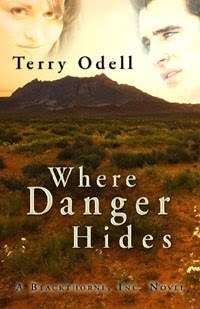 Onto the fireworks – well, more or less. Today is the official release day for WHERE DANGER HIDES, the second book in my Blackthorne, Inc. series. This means that the publisher will begin filling orders. If you ordered the book from Amazon or Barnes and Noble, the books have to arrive there from the publisher, and then they'll go out to you. The projected "real" release date is closer to June 8th.
Onto the fireworks – well, more or less. Today is the official release day for WHERE DANGER HIDES, the second book in my Blackthorne, Inc. series. This means that the publisher will begin filling orders. If you ordered the book from Amazon or Barnes and Noble, the books have to arrive there from the publisher, and then they'll go out to you. The projected "real" release date is closer to June 8th.
The publisher targets the library market, and I'm a firm believer in libraries. I know that the hard cover price of the book might be a bit steep for some in today's economy, so another way to help out is to request the book from your own library system. The information they're likely to ask for:
Title: Where Danger Hides
Author: Terry Odell
Publisher: Five Star / Gale Cengage
ISBN 10: 1432825127
ISBN 13: 978-1432825126
What else can you do? If you have an Amazon account, log in and go to the book's page:
Click the "like" button near the top, and/or scroll down to the product tags and click the boxes. Doesn't cost you anything, and helps the ranking, which can help sales.
Of course, if you want to buy the book, that's fine with me, too.
And, as a 'gift' for you, I've shared the original starting point for the book on my website. It's an addition to my "From the Cutting Room Floor" section. I hope you'll look at it. And then you can go to the final first chapter and compare. I think this will help show how it's more important to get something on the page, and worry about whether it works later. In this scene, Miri was beginning to be fleshed out, and some of her goals and motivations are there, but she underwent some major transformations, as did her first appearance in the final book. As so often happens, these first "running starts" are there for the author, as a way for us to get to know the characters. And, they're also heavy into back story for the same reason.
The business of writing doesn't happen in nice, neat blocks of time. While copies of WHERE DANGER HIDES are starting to roll out, I've been busy with the next book, ROOTED IN DANGER. I finished my first round of edits, and am very pleased with my new editor. She was happy with my changes based on her suggestions, and accepted my reasoning in places where she had questions. Because (as I've warned you to do) I went through the entire manuscript rather than simply dealing with her markups, I found a few more places where I thought tweaks might help, and we arrived at a "ready for the next step" product.
Next up. The "Ancillary Materials Form" the publisher requires. This is all the marketing stuff—with this publisher, authors are expected to provide all the copy that goes on the cover. And since these are hard cover books with full dust jackets, which means there's a front cover, and a back cover, of course. But there are also those cover flaps that wrap around the cover. In addition, the publisher puts out a catalog which it sends to libraries, and there's copy we have to write for that as well.
From my viewpoint, I could probably write five chapters with less effort and hair-pulling than writing marketing prose.
Also on my plate: updating my website to reflect all the new pages for Where Danger Hides, and to add Rooted in Danger to the Coming Soon page, as well as getting a new ebook ready to upload, and working on another book for my Pine Hills Police series.
Thanks to Kathryn Scannell for her fascinating and informative post yesterday. And don't forget the big Smashwords sale from Backlist eBook authors. Details in the Deals and Steals tab. I'm also over at The Blood Red Pencil today, talking about "R.U.E."
 Onto the fireworks – well, more or less. Today is the official release day for WHERE DANGER HIDES, the second book in my Blackthorne, Inc. series. This means that the publisher will begin filling orders. If you ordered the book from Amazon or Barnes and Noble, the books have to arrive there from the publisher, and then they'll go out to you. The projected "real" release date is closer to June 8th.
Onto the fireworks – well, more or less. Today is the official release day for WHERE DANGER HIDES, the second book in my Blackthorne, Inc. series. This means that the publisher will begin filling orders. If you ordered the book from Amazon or Barnes and Noble, the books have to arrive there from the publisher, and then they'll go out to you. The projected "real" release date is closer to June 8th. The publisher targets the library market, and I'm a firm believer in libraries. I know that the hard cover price of the book might be a bit steep for some in today's economy, so another way to help out is to request the book from your own library system. The information they're likely to ask for:
Title: Where Danger Hides
Author: Terry Odell
Publisher: Five Star / Gale Cengage
ISBN 10: 1432825127
ISBN 13: 978-1432825126
What else can you do? If you have an Amazon account, log in and go to the book's page:
Click the "like" button near the top, and/or scroll down to the product tags and click the boxes. Doesn't cost you anything, and helps the ranking, which can help sales.
Of course, if you want to buy the book, that's fine with me, too.
And, as a 'gift' for you, I've shared the original starting point for the book on my website. It's an addition to my "From the Cutting Room Floor" section. I hope you'll look at it. And then you can go to the final first chapter and compare. I think this will help show how it's more important to get something on the page, and worry about whether it works later. In this scene, Miri was beginning to be fleshed out, and some of her goals and motivations are there, but she underwent some major transformations, as did her first appearance in the final book. As so often happens, these first "running starts" are there for the author, as a way for us to get to know the characters. And, they're also heavy into back story for the same reason.
The business of writing doesn't happen in nice, neat blocks of time. While copies of WHERE DANGER HIDES are starting to roll out, I've been busy with the next book, ROOTED IN DANGER. I finished my first round of edits, and am very pleased with my new editor. She was happy with my changes based on her suggestions, and accepted my reasoning in places where she had questions. Because (as I've warned you to do) I went through the entire manuscript rather than simply dealing with her markups, I found a few more places where I thought tweaks might help, and we arrived at a "ready for the next step" product.
Next up. The "Ancillary Materials Form" the publisher requires. This is all the marketing stuff—with this publisher, authors are expected to provide all the copy that goes on the cover. And since these are hard cover books with full dust jackets, which means there's a front cover, and a back cover, of course. But there are also those cover flaps that wrap around the cover. In addition, the publisher puts out a catalog which it sends to libraries, and there's copy we have to write for that as well.
From my viewpoint, I could probably write five chapters with less effort and hair-pulling than writing marketing prose.
Also on my plate: updating my website to reflect all the new pages for Where Danger Hides, and to add Rooted in Danger to the Coming Soon page, as well as getting a new ebook ready to upload, and working on another book for my Pine Hills Police series.
Published on May 18, 2011 04:00
May 17, 2011
Inside Environmental Emergency Response
My guest, Kathryn Scannell, writes fantasy and erotic romance. Like most writers, she still has a day job, which involves working for an environmental response contractor. Today she's sharing a little of what it's like to be part of the official response to an environmental disaster.
We've all seen environmental disasters on the news in recent years. The Deepwater Horizon disaster in the Gulf last summer got a lot of coverage. Most of that coverage is focused on pictures of the disaster, with a few pictures of people in tyvek suits to spice it up. There's a lot more that goes on behind the scenes.
As an example, let's look at a smaller incident, which I had some involvement with last summer. At the end of July, there was a major oil spill in the little town of Marshall, Michigan. An underground pipeline delivering oil from Canada to a refinery in the US ruptured one night, releasing oil into the ground. It rapidly found its way to a nearby creek and from there into the Kalamazoo River. The rupture was not immediately discovered, and by the time the problem was understood and it was shut down, and EPA estimates that 819,000 gallons of oil were released. This is a tiny fraction compared to the gulf, but to the people of Marshall if was a disaster. The EPA has a web page with the background, and many pictures for anyone who would like to know more : http://www.epa.gov/enbridgespill/
Response was immediate. Residents in nearby homes were evacuated because oil fumes contain cancer causing chemicals, notably benzene, and there was concern that they were present at levels which would be a health risk. EPA response contractors and responders from Enbridge Oil, which owned the pipeline, converged on the site within hours. At first the response ran around the clock, with people working 12 hours shifts. This continued for roughly a month, until a significant fraction of the spilled oil had been recovered using floating booms, giant vacuum trucks, and excavation equipment to remove contaminated soil. Air monitoring went on around the clock too, to determine if it was safe to allow people to return to their homes.
This kind of effort requires a small army of people to coordinate. When I was there approximately a month after the initial spill, things were settling into a routine. That routine included nearly a thousand contractor employees working on the spill in one capacity or another, from hazmat workers wading in the river and removing oiled vegetation by hand to air boat operators and a helicopter crew, to data managers and map makers working in the incident command center. There were dozens of contractor companies involved, as well as multiple agencies – the Environmental Protection Agency, the Michigan Department of Environmental Quality, local Hazmat response teams, local public health officials, the US Coast Guard, and Fish and Wildlife personnel.
These diverse entities were all able to coordinate through the magic of the Incident Command System, a structure which was designed in the wake of some of the huge wildfires in the western US, to enable multiple agencies to coordinate with each other efficiently. It designates a single commander for the incident, and allows that structure to override normal ranks and jurisdictional boundaries.
There's a tremendous amount of support required for this kind of undertaking. All those responders have to have somewhere to sleep, and it would be tremendously inefficient if they were all trying to arrange their own hotel rooms, especially in an area where there isn't an adequate supply. At the Michigan spill there were people staying as far as an hour and half drive away. In the early stages of the Hurricane Katrina response people were staying in camping trailers. Since many were coming from long distances, there were plane reservations and rental cars to coordinate. Someone has to do all this, and they're often on-site too.
There were facilities to manage – we were working out of a warehouse and a small fleet of construction trailers when I was there. There were safety people to look out for the well being of the response workers – it's very common for people to get so focused on the work and the urgency of it that they don't stop and rest when they should. There was even a laundry service, because if you're working 12 hour days plus travel time, there isn't a lot of time for anything else but eating and sleeping. And of course someone has to track all the hours being worked, because those responders are getting paid to be there. (And the Michigan Department of Revenue was right there too, making sure it got its cut – I paid income tax to MI last year in addition to filing in my home state.)
It's a truly amazing thing to see a big response like that come together, to see how flawlessly people, who don't know each other and don't normally work together, can cooperate. I had never met most of the people I worked with before, even the ones from my employer, and may not meet them again unless we end up doing another response together. Our needs far outstripped the capacity of our nearest office, and people with specialized skills were brought in from all over the country. I worked closely with people from our offices in Texas, New Jersey, Arizona, and Illinois while I was there. People on these responses generally rotate in and out, with a shift of overlap with the person you're replacing, or your replacement, to get up to speed on what's been happening. You develop checklists and procedures for everything, and you document everything, because that lets you hand off the job to someone with a relatively short transition.
These responses work because of hundreds of dedicated people, most of whom will never get their picture on TV. The individual jobs aren't glamorous, but the results as a whole are nothing short of amazing. I've seen turtles sunning themselves again on a river that a month before was covered in crude oil. Knowing you were a small part of making that happen is a great thing to take home at the end of the day.
EMBRACING THE DRAGON by Kathryn Scannell is available here. You can find her on the web at http://www.kathrynscannell.com.
We've all seen environmental disasters on the news in recent years. The Deepwater Horizon disaster in the Gulf last summer got a lot of coverage. Most of that coverage is focused on pictures of the disaster, with a few pictures of people in tyvek suits to spice it up. There's a lot more that goes on behind the scenes.
As an example, let's look at a smaller incident, which I had some involvement with last summer. At the end of July, there was a major oil spill in the little town of Marshall, Michigan. An underground pipeline delivering oil from Canada to a refinery in the US ruptured one night, releasing oil into the ground. It rapidly found its way to a nearby creek and from there into the Kalamazoo River. The rupture was not immediately discovered, and by the time the problem was understood and it was shut down, and EPA estimates that 819,000 gallons of oil were released. This is a tiny fraction compared to the gulf, but to the people of Marshall if was a disaster. The EPA has a web page with the background, and many pictures for anyone who would like to know more : http://www.epa.gov/enbridgespill/
Response was immediate. Residents in nearby homes were evacuated because oil fumes contain cancer causing chemicals, notably benzene, and there was concern that they were present at levels which would be a health risk. EPA response contractors and responders from Enbridge Oil, which owned the pipeline, converged on the site within hours. At first the response ran around the clock, with people working 12 hours shifts. This continued for roughly a month, until a significant fraction of the spilled oil had been recovered using floating booms, giant vacuum trucks, and excavation equipment to remove contaminated soil. Air monitoring went on around the clock too, to determine if it was safe to allow people to return to their homes.
This kind of effort requires a small army of people to coordinate. When I was there approximately a month after the initial spill, things were settling into a routine. That routine included nearly a thousand contractor employees working on the spill in one capacity or another, from hazmat workers wading in the river and removing oiled vegetation by hand to air boat operators and a helicopter crew, to data managers and map makers working in the incident command center. There were dozens of contractor companies involved, as well as multiple agencies – the Environmental Protection Agency, the Michigan Department of Environmental Quality, local Hazmat response teams, local public health officials, the US Coast Guard, and Fish and Wildlife personnel.
These diverse entities were all able to coordinate through the magic of the Incident Command System, a structure which was designed in the wake of some of the huge wildfires in the western US, to enable multiple agencies to coordinate with each other efficiently. It designates a single commander for the incident, and allows that structure to override normal ranks and jurisdictional boundaries.
There's a tremendous amount of support required for this kind of undertaking. All those responders have to have somewhere to sleep, and it would be tremendously inefficient if they were all trying to arrange their own hotel rooms, especially in an area where there isn't an adequate supply. At the Michigan spill there were people staying as far as an hour and half drive away. In the early stages of the Hurricane Katrina response people were staying in camping trailers. Since many were coming from long distances, there were plane reservations and rental cars to coordinate. Someone has to do all this, and they're often on-site too.
There were facilities to manage – we were working out of a warehouse and a small fleet of construction trailers when I was there. There were safety people to look out for the well being of the response workers – it's very common for people to get so focused on the work and the urgency of it that they don't stop and rest when they should. There was even a laundry service, because if you're working 12 hour days plus travel time, there isn't a lot of time for anything else but eating and sleeping. And of course someone has to track all the hours being worked, because those responders are getting paid to be there. (And the Michigan Department of Revenue was right there too, making sure it got its cut – I paid income tax to MI last year in addition to filing in my home state.)
It's a truly amazing thing to see a big response like that come together, to see how flawlessly people, who don't know each other and don't normally work together, can cooperate. I had never met most of the people I worked with before, even the ones from my employer, and may not meet them again unless we end up doing another response together. Our needs far outstripped the capacity of our nearest office, and people with specialized skills were brought in from all over the country. I worked closely with people from our offices in Texas, New Jersey, Arizona, and Illinois while I was there. People on these responses generally rotate in and out, with a shift of overlap with the person you're replacing, or your replacement, to get up to speed on what's been happening. You develop checklists and procedures for everything, and you document everything, because that lets you hand off the job to someone with a relatively short transition.
These responses work because of hundreds of dedicated people, most of whom will never get their picture on TV. The individual jobs aren't glamorous, but the results as a whole are nothing short of amazing. I've seen turtles sunning themselves again on a river that a month before was covered in crude oil. Knowing you were a small part of making that happen is a great thing to take home at the end of the day.
EMBRACING THE DRAGON by Kathryn Scannell is available here. You can find her on the web at http://www.kathrynscannell.com.
Published on May 17, 2011 05:00



